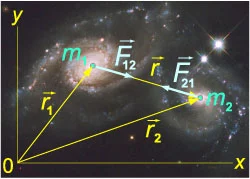Newton’s Law of Universal Gravitation
The Force of Gravity and Gravitational Potential
The law of universal gravitation was formulated by Isaac Newton \(\left(1643-1727\right)\) and published in \(1687.\)

In accordance with this law, two point masses attract each other with a force that is directly proportional to the masses of these bodies \({m_1}\) and \({m_2},\) and inversely proportional to the square of the distance between them:
Here, \(r\) is the distance between the centers of mass of the bodies, \(G\) is the gravitational constant, whose value found by experiment is \(G = 6,67 \times {10^{ - 11}}{\frac{{{\text{m}^3}}}{{\text{kg} \cdot {\text{s}^2}}}}.\)
The force of gravitational attraction is a central force, that is directed along a line passing through the centers of the interacting bodies.
In a system of two bodies (Figure \(2\)), the attraction force \({\mathbf{F}_{12}}\) of the second body acts on the first body of mass \({m_1}.\)

Similarly, the attraction force \({\mathbf{F}_{21}}\) of the first body acts on the second body of mass \({m_2}.\) Both the forces \({\mathbf{F}_{12}}\) and \({\mathbf{F}_{21}}\) are equal and directed along \(\mathbf{r},\) where
Using the Newton's second law we can write the following differential equations describing the motion of each body:
or
It follows from the last two equations that
This differential equation describes the change of the vector \(\mathbf{r}\left( t \right),\) that is, the relative motion of two bodies under the force of gravitational attraction.
With a large difference in mass of the bodies, we can neglect the smaller body mass in the right side of this equation. For example, the mass of the Sun is \(333,000\) times greater than the mass of the Earth. In this case, the differential equation can be written in a simpler form:
where \({M_\text{S}}\) is the mass of the Sun.
The gravitational interaction of bodies takes place through a gravitational field, which can be described by a scalar potential \(\varphi.\) The force acting on a body of mass \(m,\) placed in a field with potential \(\varphi,\) is equal to
In the case of a point mass \(M,\) the potential of the gravitational field is given by
The latter formula is also valid for distributed bodies with central symmetry, such as a planet or star.
Kepler's Laws
The basic laws of planetary motion were established by Johannes Kepler \(\left(1571-1630\right)\) based on the analysis of astronomical observations of Tycho Brahe \(\left(1546-1601\right)\). In \(1609,\) Kepler formulated the first two laws. The third law was discovered in \(1619.\) Later, in the late \(17\)th century, Isaac Newton proved mathematically that all three laws of Kepler are a consequence of the law of universal gravitation.
Kepler's First Law
The orbit of each planet in the solar system is an ellipse, one focus of which is the Sun (Figure \(3\)).

Kepler's Second Law
The radius vector connecting the Sun and the planet describes equal areas in equal intervals of time. Figure \(4\) shows the two sectors of the ellipse corresponding to the same time intervals.

According to Kepler's second law, the areas of these sectors are equal.
Kepler's Third Law
The square of the orbital period of a planet is proportional to the cube of the semi-major axis of its orbit:
The proportionality coefficient is the same for all planets in the solar system. Therefore, for any two planets, one can write the relationship